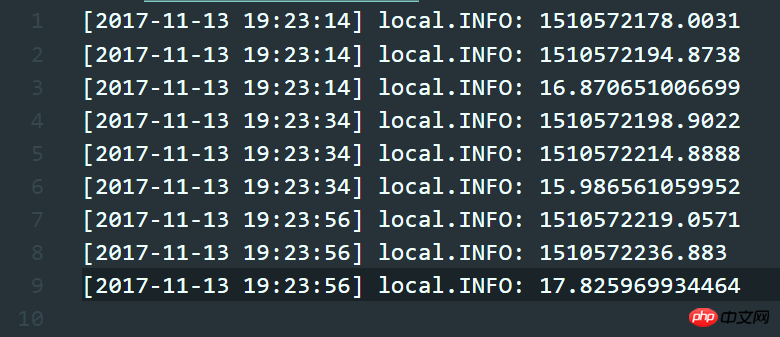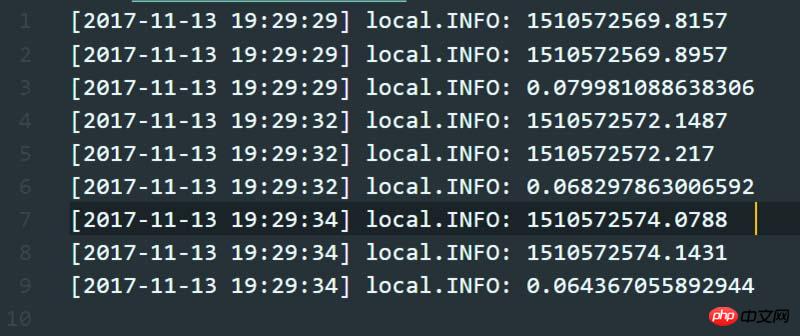 Backend Development
Backend Development
 PHP Tutorial
PHP Tutorial
 Detailed explanation of Laravel image processing extension package Intervention/image
Detailed explanation of Laravel image processing extension package Intervention/image
Detailed explanation of Laravel image processing extension package Intervention/image
This article mainly introduces to you the installation and use of the Intervention/image image processing extension package in Laravel and the solutions to the pitfalls that may be encountered in use. The article introduces it in great detail through sample code, which is very useful for your study or work. It has certain reference and learning value. Friends who need it can follow the editor to learn together. I hope to be helpful.
Preface
Intervention/image is an image processing tool customized for Laravel. It provides a set of easy-to-express methods. Create and edit images.
Demo
Demo screenshot

Demo Run
Please refer to the document how to use Homestead to quickly run a Laravel project.
Article Overview
Installation;
Modify configuration information;
Basic usage ;
- ##Special features.
The following is a detailed explanation.
##1. Install
composer require intervention/image
2). Modify app/config/app.php and add ServiceProvider:
// 将下面代码添加到 providers 数组中
'providers' => [
// ...
Intervention\Image\ImageServiceProvider::class,
// ...
],
// 将下面代码添加到 aliases 数组中
'aliases' => [
// ...
'Image' => Intervention\Image\Facades\Image::class,
// ...
],
2. Image processing library configuration
This extension package uses PHP's GD library for image processing by default, but since the GD library's image processing efficiency is slightly inferior to the imagemagick library, it is recommended to replace it with the imagemagick library for image processing.
Before you start, you must first make sure that GD or Imagick has been installed locally.
When using Intervention Image, you only need to pass an array parameter to ImageManager to complete the communication between GD and Imagick libraries. Switch between each other.
As shown below:
// 引入 composer autoload require 'vendor/autoload.php'; // 导入 Intervention Image Manager Class use Intervention\Image\ImageManager; // 通过指定 driver 来创建一个 image manager 实例 $manager = new ImageManager(array('driver' => 'imagick')); // 最后创建 image 实例 $image = $manager->make('public/foo.jpg')->resize(300, 200);
Alternatively, you can also use the static version of ImageManager, as shown below:
// 引入 composer autoload require 'vendor/autoload.php'; // 导入 Intervention Image Manager Class use Intervention\Image\ImageManagerStatic as Image; // 通过指定 driver 来创建一个 image manager 实例 (默认使用 gd) Image::configure(array('driver' => 'imagick')); // 最后创建 image 实例 $image = Image::make('public/foo.jpg')->resize(300, 200);
Generate the config/image.php configuration file:
php artisan vendor:publish --provider="Intervention\Image\ImageServiceProviderLaravel5"
After running the above command, the config/image.php configuration file will be generated in the project. Open this file and modify the driver to imagick:
return array( 'driver' => 'imagick' );
This is it, this expansion package is Installation successful!
3. Basic usage// 修改指定图片的大小
$img = Image::make('images/avatar.jpg')->resize(200, 200);
// 插入水印, 水印位置在原图片的右下角, 距离下边距 10 像素, 距离右边距 15 像素
$img->insert('images/watermark.png', 'bottom-right', 15, 10);
// 将处理后的图片重新保存到其他路径
$img->save('images/new_avatar.jpg');
/* 上面的逻辑可以通过链式表达式搞定 */
$img = Image::make('images/avatar.jpg')->resize(200, 200)->insert('images/new_avatar.jpg', 'bottom-right', 15, 10);
4. Featured functions
In addition to the basic usage introduced above, this expansion pack also supports:
- Image upload function;
- Image caching function;
- Image filtering function: Convert images according to unified rules;
- Dynamic image processing: According to the URL of accessed images Parameters automatically adjust image size
- For more examples, please refer to the official documentation.
A small pit in intervention/image and its How to crack itIn fact, intervention/iamge has been used for a long time. Its API is very concisely designed, the documentation is also very comprehensive, and it is quite easy to use.
But recently I accidentally discovered a small pit. Because I need to synthesize a QR code with a WeChat avatar, I use Image::make($avatarUrl) ($avatarUrl here is the link to the WeChat avatar) to generate the avatar, and then synthesize it into the QR code image (including some other operations, such as using template backgrounds and writing text).
After I finished writing, I found that it was quite slow when I ran it, taking about 23 seconds on average. At first I thought it was because there were many operations and the size was relatively large during the synthesis process, so it should have been this speed. But then I got some free time and started trying to optimize. Even if I couldn't improve the speed, I could at least figure out why it was so time-consuming.
After much fiddling around, I discovered that the truth has little to do with the number and size of synthesis operations. The key lies in the pose in which I create the avatar data.
In order to illustrate this problem, the following code was specially written for comparison.
// 记录开始时间 $startTimestamp = microtime(true); $url = 'http://wx.qlogo.cn/mmopen/XxT9TiaJ1ibf06TNRCMjQADS4opDHvQLguLZHpqkRlvuJYZicvJW4iaOalPsKIs0kpZ3F6864ZzibyObYiaucUQSrdp4pFTNDyIpxw/0'; $avatar = \Image::make($url); // 记录结束时间 $endTimestamp = microtime(true); info($startTimestamp); info($endTimestamp); info($endTimestamp - $startTimestamp);

The above code uses the form of Image::make($url) to generate an avatar directly from the url. Judging from the recorded log data, the time taken is basically around 16 seconds.
Later, I thought of a new posture. In fact, I came up with it while trying to optimize. See the code below:
$startTimestamp = microtime(true); $client = new \GuzzleHttp\Client(); $url = 'http://wx.qlogo.cn/mmopen/XxT9TiaJ1ibf06TNRCMjQADS4opDHvQLguLZHpqkRlvuJYZicvJW4iaOalPsKIs0kpZ3F6864ZzibyObYiaucUQSrdp4pFTNDyIpxw/0'; $avatarResponse = $client->get($url); $avatar = \Image::make($avatarResponse->getBody()->getContents()); $endTimestamp = microtime(true); info($startTimestamp); info($endTimestamp); info($endTimestamp - $startTimestamp);
Here I first use GuzzleHttp to get the avatar, and then use Image::make($data) to create the avatar.
Attention, it’s about to climax... sunglasses
Look at the screenshot of the log below. The average time taken three times is about 0.07 seconds, which is more than 200 times worse than the previous 16 seconds.

As for why this phenomenon occurs, I don’t know yet, but this is undoubtedly a useful and niche experience.
Related recommendations:
Detailed explanation of Laravel’s localization module
Detailed explanation of how to obtain routing parameters in Laravel
Detailed explanation of the loading process and principle of Facade in Laravel
The above is the detailed content of Detailed explanation of Laravel image processing extension package Intervention/image. For more information, please follow other related articles on the PHP Chinese website!

Hot AI Tools

Undresser.AI Undress
AI-powered app for creating realistic nude photos

AI Clothes Remover
Online AI tool for removing clothes from photos.

Undress AI Tool
Undress images for free

Clothoff.io
AI clothes remover

AI Hentai Generator
Generate AI Hentai for free.

Hot Article

Hot Tools

Notepad++7.3.1
Easy-to-use and free code editor

SublimeText3 Chinese version
Chinese version, very easy to use

Zend Studio 13.0.1
Powerful PHP integrated development environment

Dreamweaver CS6
Visual web development tools

SublimeText3 Mac version
God-level code editing software (SublimeText3)

Hot Topics
 1377
1377
 52
52
 Comparison of the latest versions of Laravel and CodeIgniter
Jun 05, 2024 pm 05:29 PM
Comparison of the latest versions of Laravel and CodeIgniter
Jun 05, 2024 pm 05:29 PM
The latest versions of Laravel 9 and CodeIgniter 4 provide updated features and improvements. Laravel9 adopts MVC architecture and provides functions such as database migration, authentication and template engine. CodeIgniter4 uses HMVC architecture to provide routing, ORM and caching. In terms of performance, Laravel9's service provider-based design pattern and CodeIgniter4's lightweight framework give it excellent performance. In practical applications, Laravel9 is suitable for complex projects that require flexibility and powerful functions, while CodeIgniter4 is suitable for rapid development and small applications.
 How do the data processing capabilities in Laravel and CodeIgniter compare?
Jun 01, 2024 pm 01:34 PM
How do the data processing capabilities in Laravel and CodeIgniter compare?
Jun 01, 2024 pm 01:34 PM
Compare the data processing capabilities of Laravel and CodeIgniter: ORM: Laravel uses EloquentORM, which provides class-object relational mapping, while CodeIgniter uses ActiveRecord to represent the database model as a subclass of PHP classes. Query builder: Laravel has a flexible chained query API, while CodeIgniter’s query builder is simpler and array-based. Data validation: Laravel provides a Validator class that supports custom validation rules, while CodeIgniter has less built-in validation functions and requires manual coding of custom rules. Practical case: User registration example shows Lar
 Laravel - Artisan Commands
Aug 27, 2024 am 10:51 AM
Laravel - Artisan Commands
Aug 27, 2024 am 10:51 AM
Laravel - Artisan Commands - Laravel 5.7 comes with new way of treating and testing new commands. It includes a new feature of testing artisan commands and the demonstration is mentioned below ?
 Which one is more beginner-friendly, Laravel or CodeIgniter?
Jun 05, 2024 pm 07:50 PM
Which one is more beginner-friendly, Laravel or CodeIgniter?
Jun 05, 2024 pm 07:50 PM
For beginners, CodeIgniter has a gentler learning curve and fewer features, but covers basic needs. Laravel offers a wider feature set but has a slightly steeper learning curve. In terms of performance, both Laravel and CodeIgniter perform well. Laravel has more extensive documentation and active community support, while CodeIgniter is simpler, lightweight, and has strong security features. In the practical case of building a blogging application, Laravel's EloquentORM simplifies data manipulation, while CodeIgniter requires more manual configuration.
 Laravel vs CodeIgniter: Which framework is better for large projects?
Jun 04, 2024 am 09:09 AM
Laravel vs CodeIgniter: Which framework is better for large projects?
Jun 04, 2024 am 09:09 AM
When choosing a framework for large projects, Laravel and CodeIgniter each have their own advantages. Laravel is designed for enterprise-level applications, offering modular design, dependency injection, and a powerful feature set. CodeIgniter is a lightweight framework more suitable for small to medium-sized projects, emphasizing speed and ease of use. For large projects with complex requirements and a large number of users, Laravel's power and scalability are more suitable. For simple projects or situations with limited resources, CodeIgniter's lightweight and rapid development capabilities are more ideal.
 Questions and Answers on PHP Enterprise Application Microservice Architecture Design
May 07, 2024 am 09:36 AM
Questions and Answers on PHP Enterprise Application Microservice Architecture Design
May 07, 2024 am 09:36 AM
Microservice architecture uses PHP frameworks (such as Symfony and Laravel) to implement microservices and follows RESTful principles and standard data formats to design APIs. Microservices communicate via message queues, HTTP requests, or gRPC, and use tools such as Prometheus and ELKStack for monitoring and troubleshooting.
 Laravel vs CodeIgniter: Which framework is better for small projects?
Jun 04, 2024 pm 05:29 PM
Laravel vs CodeIgniter: Which framework is better for small projects?
Jun 04, 2024 pm 05:29 PM
For small projects, Laravel is suitable for larger projects that require strong functionality and security. CodeIgniter is suitable for very small projects that require lightweight and ease of use.
 Which is the better template engine, Laravel or CodeIgniter?
Jun 03, 2024 am 11:30 AM
Which is the better template engine, Laravel or CodeIgniter?
Jun 03, 2024 am 11:30 AM
Comparing Laravel's Blade and CodeIgniter's Twig template engine, choose based on project needs and personal preferences: Blade is based on MVC syntax, which encourages good code organization and template inheritance. Twig is a third-party library that provides flexible syntax, powerful filters, extended support, and security sandboxing.



